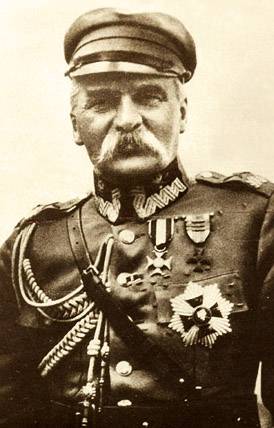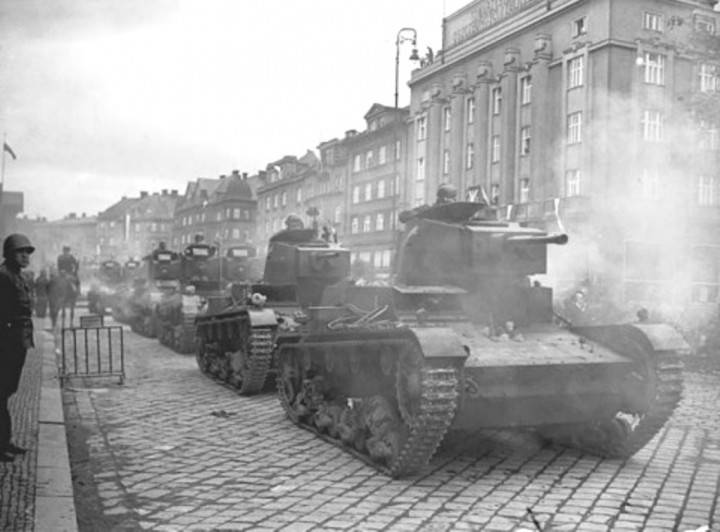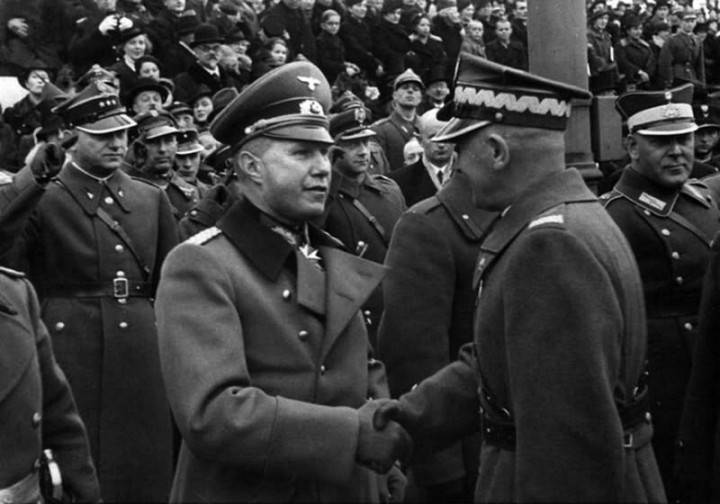How Poland was an ally of Hitler
 When Adolf Hitler came to power in Germany, in a number of countries in Eastern Europe, and Poland was no exception among them, right-wing authoritarian regimes already existed, ideologically being much closer to Hitler than to the Soviet Union and even Western countries. Since May 1926, the power in Poland has actually been in the hands of the Minister of War Marshal Jozef Pilsudski - one of the veterans of the Polish national movement who came to power as a result of the May coup of 1926. The influence of parliament in the country was limited, many civil rights and freedoms were curtailed. In 1934, Poland concluded a non-aggression pact with Hitler Germany. It was signed on 26 on January 1934 of the year in Berlin. On the German side, the signature was put by Foreign Minister Konstantin von Neurath, on the Polish side by the Ambassador of Poland to Germany, Jozef Lipsky.
When Adolf Hitler came to power in Germany, in a number of countries in Eastern Europe, and Poland was no exception among them, right-wing authoritarian regimes already existed, ideologically being much closer to Hitler than to the Soviet Union and even Western countries. Since May 1926, the power in Poland has actually been in the hands of the Minister of War Marshal Jozef Pilsudski - one of the veterans of the Polish national movement who came to power as a result of the May coup of 1926. The influence of parliament in the country was limited, many civil rights and freedoms were curtailed. In 1934, Poland concluded a non-aggression pact with Hitler Germany. It was signed on 26 on January 1934 of the year in Berlin. On the German side, the signature was put by Foreign Minister Konstantin von Neurath, on the Polish side by the Ambassador of Poland to Germany, Jozef Lipsky. Before the signing of the pact, Poland unsuccessfully tried to form an anti-Hitler bloc, but then the Polish leadership revised its foreign policy course. This was due to the desire of Poland to revise the borders of Eastern European countries, established by the Versailles Treaty. In the period between the two world wars, Czechoslovakia represented a rather actively developing economy, but at the same time more powerful neighbors — Germany, Hungary, and Poland — attempted to encroach on its territory. In addition, Slovak nationalists, who had connections with Nazi Germany and counted on the creation of an independent Slovak state, acted in Czechoslovakia itself. Germany claimed the Sudetenland, where a significant part of the population were ethnic Germans. Hungary sought to get under its control the territory of Subcarpathian Rus, where a large Magyar population lived. Poland also claimed a large part of Czechoslovakia — the eastern region of Cieszyn Silesia, which had a great economic potential and was populated not only by Czechs, but also by ethnic Poles.
For the partition of Czechoslovakia, the Polish leadership wanted to enlist the support of Germany and Hungary. Poland was also viewed by the Soviet Union as a much more likely enemy than Hitler’s Germany. The anti-communist and Russophobic views of the Polish leadership, who hated everything Russian and the Soviet Union as a continuation of the Russian state, had their effect. Therefore, the Polish leadership was preparing for the partition of Czechoslovakia, counting on the support of Nazi Germany. Although a nonaggression pact was signed between the USSR and Poland, in fact, Poland continued to pursue an anti-Soviet policy. The communist movement during the rule of Pilsudski was subjected to unprecedented persecution, especially in the territory of Western Ukraine and Western Belarus.
Soon an event occurred in Poland that had great consequences for the country. 12 May 1935 of the year 20 hours 45 minutes Jozef Pilsudski died of liver cancer. A mourning delegation led by Hermann Göring arrived from Germany. The death of Pilsudski, who was still trying to somehow balance between the powers, led to some changes in the country's foreign policy. The heirs of the marshal sought to further toughen the anti-Soviet orientation of Polish politics. There was an almost open reorientation of the country's foreign policy towards cooperation with Nazi Germany. 31 August 1937, the Polish General Staff adopted a secret directive, which set the task of the Polish army to destroy "any Russia", regardless of the political system and the dominant ideology. Unlike Poland, the Soviet Union was well aware of the danger posed to Europe from Hitler and repeatedly proposed the creation of a block to defend Germany’s aggressive plans. But this was not to be. In 1938, Poland openly took the side of Germany. At first, the Polish leadership actually supported the Anschluss of Austria, stating that this is an internal affair of Germany. Thus, the impetus was given to the redistribution of post-war borders. Already five days after the Anschluss of Austria, March 17 1938, Poland presented an ultimatum to Lithuania. In addition, preparations began for the rejection of Cieszyn Silesia from Czechoslovakia. Poland by this time was in actual collusion with Hungary and Germany, intending to dismember the Czechoslovak state.

Despite the fact that Czechoslovakia was a Slavic state, Poland did not abandon the idea of profit from the territory at the expense of its neighbor. In this case, the Czechs and Slovaks belonging to the same Western Slavs as the Poles did not have any meaning for the Polish leadership. September 21 Poland 1938 demanded that Czechoslovakia transfer the eastern part of Cieszyn Silesia to Polish control. On September 30, nine days later, Warsaw reiterated its demand, and on October 1, Polish troops were introduced to Czechoslovakia on October 1938. Cieszyn Silesia was occupied, after which it became part of Poland as a Western Cieszyn district. October 2 1938, Marshal Edward Rydz-Smigly, made a statement regarding the reunification of Cieszyn Silesia with Poland. So Warsaw was a member of the treacherous division of the Czechoslovak state.
11 November 1938 held a military parade in Warsaw, dedicated to the annexation of Czechoslovak lands to Poland. Then the whole world was spread around the photograph of the friendly handshake of Marshal of Poland Edward Rydz-Smigly and the German military attache of Colonel Bogislav von Studnitz, which was intended to demonstrate the active military-political cooperation of the two states.

The accession of Cieszyn Silesia was of great economic importance for the Polish state. First, the 35 of thousands of Czechs after the annexation of Poland to Poland fled to Czechoslovakia, which led to the confiscation of their movable and immovable property in favor of the Polish state. Secondly, under the control of Poland were metallurgical enterprises. The Cieszyn region accounted for 47% of steel smelted in Poland and 41% of pig iron. In fact, it was blatant robbery of the Czechoslovak state, in which Poland took the most active part. There is no doubt that if the situation had been different, Poland would have taken a part in plundering and dismembering the Soviet Union without a twinge of conscience. After all, the directive of the Polish General Staff prescribed precisely the rout of "any Russia" as a strategic task of Polish policy "in the East."
Polish Foreign Minister Jozef Beck did not hide his ambitious plans to join the Polish state of the Ukrainian and Belarusian territory, as well as the exit of Poland to the Black Sea. Of course, the leadership of Nazi Germany was not going to allow Poland to annex Ukraine and Belarus, as she herself had plans for these territories of the Soviet Union. However, to preserve the visibility of the allied relations with Poland, German diplomats persistently assented to their Polish colleagues. Moreover, the top leaders of the Third Reich, including, for example, Hermann Goering, repeatedly urged the Polish leadership that Germany was ready to deal with Poland with the threat from Poland. Goering said that Russia in any form, be it a monarchy or a republic, historically threatened Central and Eastern Europe, and this is where the strategic interests of Poland and Germany coincide. For Polish politicians, these words were like a balm for the soul. After all, the then Polish elite hated not only the Soviet state, but also Russia, the Russian people and Russian culture in general. Naturally, to fight the USSR / Russia, Polish leaders were ready to unite with anyone, including Adolf Hitler.
There was another terrible truth. Polish leadership from the beginning of the 1930's. pursued a policy of discrimination against foreign communities, first of all - Jews. Therefore, in Warsaw, they were completely in solidarity with the Nazis in relation to the Jewish question, perhaps not in such radical forms. When thousands of Jews who had Polish citizenship but lived in Germany were expelled from Hitler's Germany to the 17 border with Poland, the Polish leadership refused to accommodate their own citizens, even if they were Jewish. By the way, during the Second World War, Polish nationalists, not only who fought on Hitler’s side, but also his opponents, took part in the genocide of the Jewish population in Poland. Now, when the subject of the Holocaust is raised by influential Jewish communities in the USA and Western Europe, the Polish leadership is trying to keep quiet about the crimes of its ideological predecessors, about the state policy of anti-Semitism, which took place long before the occupation of Poland by Hitler's forces in 1939.
But Poland is taking steps to push Russia away from participation in commemorative events in honor of the Sobibor uprising. As is known, the Sobibor concentration camp was organized by the Nazis in 200 km southeast of Warsaw (the present Lublin province). Among his prisoners were many citizens of the Soviet Union. Soviet citizen Alexander Aronovich Pechersky and led the legendary Sobiborov uprising. Served as a technician-quartermaster 2 rank in the position of clerk, Alexander Pechersky was captured and was in a death camp. Part of the prisoners managed to escape into the woods. Pechersky was among them. He became a partisan, took part in the fight against the Nazis in Belarus, then served in the 15 st attack rifle battalion and was promoted to captain. After the end of the war, Alexander Aronovich returned to Rostov-on-Don, worked as an administrator at the Musical Comedy Theater and lived to be 1990. It turns out that Russia cannot represent a resident of Rostov-on-Don, who led the Sobiborov uprising, but Poland is present in the commission, on whose territory there was a concentration camp and whose citizens from among the collaborators took an active part in the genocide of the Jewish population and in the fight against partisans . The surviving victims of the genocide recalled with horror the Polish collaborationists who were distinguished by their particular cruelty.
By the way, Polish collaborators played an important role in the security system created by the Nazi occupation authorities on Polish territory. The Poles loyal to the Third Reich met with a favorable attitude on the part of the Nazis and were even recognized as “racially full”. Polish citizens were equipped with so-called. "Blue Police", subordinated to the German police and used in the fight against the guerrilla and anti-fascist movement, in the protection of Jewish ghettos. Only Soviet troops captured more than 60 thousand Wehrmacht soldiers from among the citizens of Poland. Although a significant part of the Poles fought against Hitler's Germany, it must not be forgotten that there were many collaborators among the Poles, and, unlike the USSR, many representatives of the Polish elite joined the collaborationists.
When Hitler Germany attacked Poland in September 1939, it was only a conflict between two former “accomplices” over the dismemberment of Czechoslovakia. There is nothing surprising in the fact that the Soviet Union did not defend the absolutely Russophobic and anti-Soviet regime of Poland from the Nazis. This would be equivalent to the fact that a normal person would intervene in a fight between two criminals that arose over the sharing of stolen loot. By the way, the German attack on Poland itself became possible, including thanks to the annexation of Czechoslovakia, after which part of the Czechoslovak lands became part of the protectorate of Bohemia and Moravia, and some became part of the puppet Slovakia, allied to Hitler. That is, Poland dug his own grave with his own hands. Then Marshal Rydz-Smigly personally refused to give permission to the Red Army to pass through Polish territory, effectively depriving Poland of the only possible defense against Nazi Germany.
Now the Polish leadership is trying to present the situation as if it were the Soviet Union, not Poland, in collusion with Hortic Hungary and Hitler Germany divided the territory of Czechoslovakia in 1938, and before that he had welcomed the takeover of Austria. It is Poland that, along with Germany and its other allies, bears the most direct blame for the outbreak of World War II, which, by the way, actually began not with an attack on Poland, but with the division of Czechoslovakia and the destruction of an independent Czechoslovak state. This section took place with the connivance of the West and the direct participation of Poland.
Information